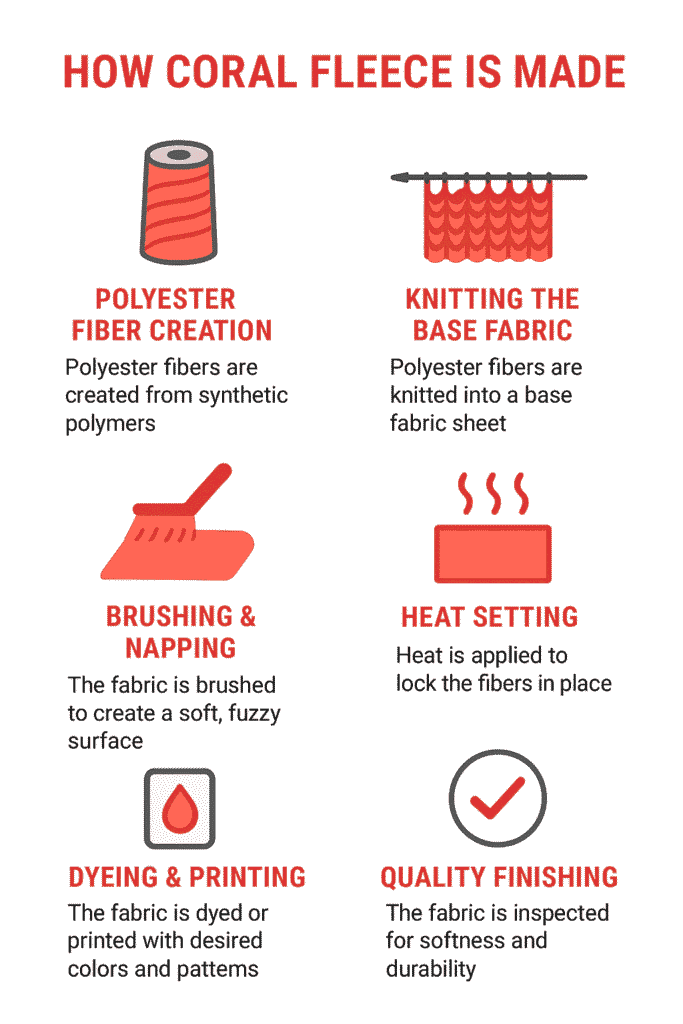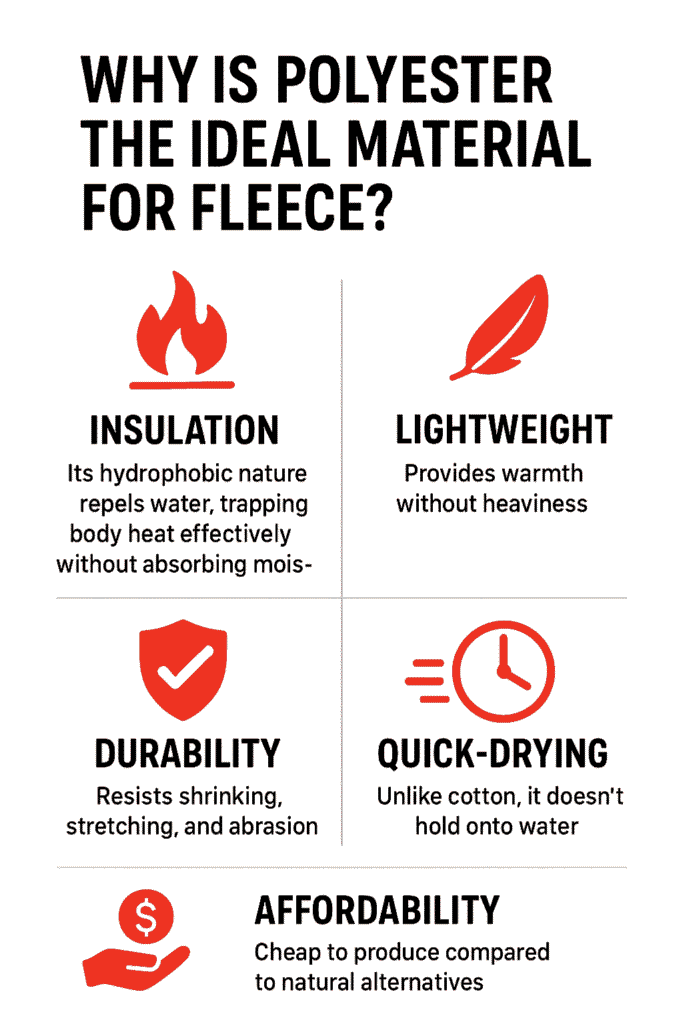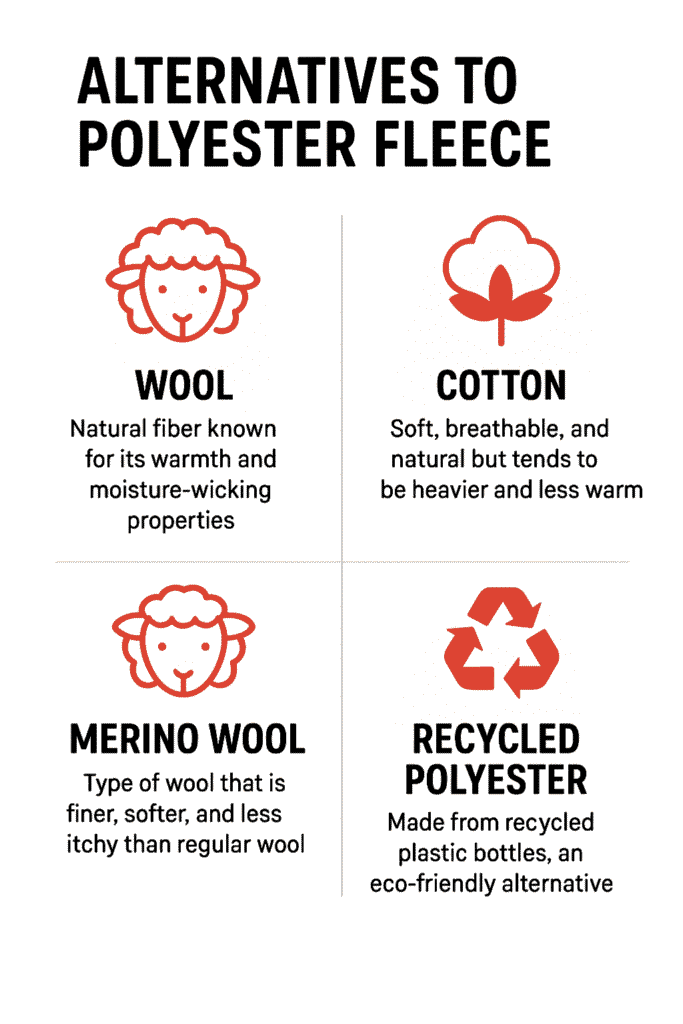Is Fleece Polyester?
The majority of modern fleece is made of polyester. Nevertheless, there is also a more complicated relationship between fleece and polyester. You could simply think of it as follows all fleece is technically polyester but not all polyester is fleece. Polyester is the raw, and fleece a finished product brought together using special fabric construction. Fleece is one of the most commonly used synthetic fibers in the world, beloved because of its warmth and softness and relative affordability.
In the following article, we will decipher the enigma of fleece and polyester. It will tell you the process of creating fleece, why you should use polyester, the effects of the processed-type, merits and demerits, and how it can be taken care of as well as some environmental alternatives. By the end, you are bound to see the effect: is fleece polyester?
Fleece vs. Polyester
What is Polyester?
Polyester is an artificial material produced out of chemicals obtained by petroleum. It is the molten form and spinned into fibers. Such fibers may be woven or knitted into a broad variety of fabrics. Polyesters are strong, resistant to shrinking and stretching and are economical. Due to these characteristics, it is the most popular clothing material in fashion, upholstery, and sports apparel.
Polyester simply put is the ingredient. As flour is used in baking, polyester can be converted to many different end products including fleece.
What is Fleece?
The fleece is not a raw material, but it is rather a form of fabric construction. Fleeces are made of forming polyester fibers in a knitting base fabric. This is then cleaned up and brushed to form a fluffy surface feel that is warm and insulating. This is what makes fleece feel so soft and fluffy and its ability to trap heat so well.
To compare, the polyester is the flour, the fleece is the bread. Fleece would not be available as it is in a modern synthetic fashion without the use of polyester.
How is Polyester Turned into Fleece? – The Manufacturing Process
It is interesting to produce fleece since this material turns a stiff plastic polymer into something soft and warm as a blanket.

Polyester Pellets
The procedure commences with small pellets of polyester that are a product of chemicals made of petroleum. All polyester fabrics are made from these small pellets including fleece. They are of uniform weight, easy to carry and transport to industrial applications. Without these pellets it was not possible to produce polyester fleece at a large scale.
Melting
Then the polyester pellets are taken to very high temperatures such that it turns into a melted liquid. The importance of this step is that it makes the pellets flexible and ready to be shaped into fibers. Its molten state enables uniformity in fibers and the magnitude of the same. This step establishes the pre-requisites of the softness and strength of the final fleece fabric.
Spinning into Yarn
When it is melted, the polyester is pushed through a spinneret, a machine with teeny holes all over it. This makes fine, continuous strand of artificial fiber which are similar to long threads. These fibers then are cooled, stretched and are twisted into yarns. This yarn quality would in turn determine the quality of the end product which is the fleece in terms of strength and softness.
Knitting into Fabric
The polyester fibre is knitted and combined to make large swatches of cloth. At this point the cloth does not appear terribly fluffy like fleece. The stretch, flexibility and the strength of the base of the fabric is determined by the knitting process. This is now a ready base fabric to undergo the finishing steps turning it into fleece.
Brushing
A smooth polyester material is put into a series of wire brushes that pull and raise the surface fibers. This process of brushing forms a fluffy, and soft material that entraps the air and incorporates insulation and warmth. The lofted fibers replicate the comfortability of natural wool making fleece so comfy. It is this step which changes the basic polyester fabric into something exceptionally comfortable.
Shearing
Once the brushing is over, the surface fibers are not even at a length. These fibers are sheared off at a uniform pile height. This makes the fabric feel even and smooth all over its surface. It also enhances the looks, and the fleece looks neat and professional.
Recycled Polyester Fleece (rPET)
A lot of manufacturers currently use recycled polyester (rPET) rather than virgin polyester. This is through cutting reused plastic bottles and other waste in a form of new polyester pellets. Not only would this minimize land fill waste but it would also reduce the number of carbon emissions in the production of fleece. Recycled fleece is recycled and feels and performs just like regular fleece making it an environmental-friendly substitute.
Why Is Polyester the Ideal Material for Fleece?

Outstanding Insulation: Polyester fiber has hydrophobic cells (resistant to water) so they will not absorb moisture. Rather than taking sweat or rain, polyester retains the moisture on top of its surface where it evaporates. Fleece has good insulative capabilities because the fibers simply trap air between them and since they remain dry, they hold warmth like wool.
Warm with light weight: Despite being very warm, fleece is very light. The feathery base of the fleece is lightweight and offers good loft to keep warm with relatively low quantities of materials being used. The reason outdoor enthusiasts enjoy fleece is the warmth, without the bulk
weight. The sweater you chose is thick and made out of wool but a fleece jacket serves the same purpose and is less weighty.
Durability: Polyester materials are wear resistant, tear and abrasion resistant. According to one source: polyester is resistant to tears, to abrasion, and against mechanical damage. This wearability implies that fleece clothes withstand harsh treatment and have the capacity to last years without distorting. Fleece is also wash resistant to shrinking or stretching. Most fleece can be washed and it will resist shrinking.
Quick-Drying: The polyester is moisture repellent and therefore fleece dries fast. A fleece jacket will not remain wet when you perspire or get sprinkled with light showers.
Affordability: Polyester is a relatively inexpensive petroleum-based material which translates to relatively low cost in fleece clothing. It is not uncommon to hear brands cite how a fleece jacket could cost far less than a similar wool jacket
insights. This cost advantage aided in making fleece omnipresent in sportswear and casual wear. Fleece became popular in the 1980s in part due to the ability of companies to produce bright, durable colors inexpensively.
Types of Polyester Fleece
There are several varieties of polyester fleece, each suited to different uses. They differ by weight, pile length, or blend:
Polar Fleece
Polar fleece is the classic, all-purpose fleece. It has a double-sided pile (brushed on both sides) for extra warmth. Polar fleece is ubiquitous in jackets, blankets, and linings. It’s designed to mimic the insulating quality of wool but is lighter and easier to care for. Polar fleece was first developed in the 1970s (by Polartec) as a synthetic wool substitute. Today, any midweight fleece you see is often called “polar fleece.”
Microfleece
Microfleece is a lighter, thinner version of polar fleece. It is usually double-sided but with a very fine (short) pile. Microfleece is extremely soft and has a low profile – it doesn’t puff up much. Because it weighs less (often under 6 ounces per square yard), microfleece is ideal for base layers and activewear. It insulates well for its weight and packs down small. However, it is not as warm as thicker fleeces. In short, microfleece is a “micro” version of standard fleece – great for layering under a jacket or wearing during exercise.
Sherpa Fleece
Sherpa fleece (also called faux-sherpa or boa fleece) mimics the look and feel of a sheep’s wool fleece. It is made of polyester but has a curly, looped pile on one side. Sherpa is typically one side fluffy like a sheep’s wool, while the other side is a smooth knit. It is extremely soft, warm, and plush – picture the lining of a cozy winter coat. Sherpa fleece is very bulky and fluffy, making it excellent for hoodies, linings, and decorative trims. Fashionably, it has “blown up” in popularity for hats, vests, and jackets because of its very visible, wool-like texture. It tends to shed a bit of fluff with wear (though modern Sherpas are engineered to hold their pile).
Technical Fleece
A high-performance adaptation of traditional fleece, technical fleece has been designed, in particular, to work under active and outdoor conditions. These fabrics were pioneered with brands such as Patagonia with the Synchilla® (which used Polartec) and Polartec itself. Technical fleece, in contrast to standard fleece, frequently utilizes moisture-wicking material so it is perfect as an exercise outfit like hiking, skiing, or running. It can provide outstanding insulation at the same time as avoiding excess heating and therefore is a reliable product among outdoor activities.
Blended Fleece
Blended fleece contains polyester mixed with different fibers including cotton, spandex or rayon in order to increase performance. Cotton balances comfort and ventilation and spandex enhances stretchiness and suppleness. These mixtures are regular in daily attire such as sweatshirts, hoodies, and lounge any dressings whose comfort in use and durability are present. Combining the fibers, the manufacturers develop products of the fleece fabrics that are more than warm.
Pros and Cons of Polyester Fleece
Pros of Polyester Fleece
- Lightweight yet warm
- Quick-drying and moisture-resistant
- Durable and resistant to stretching
- Affordable compared to natural fibers
- Easy to wash and maintain
Cons of Polyester Fleece
- Environmental Impact: Fleece is petroleum-based and sheds microplastics during washing, which pollutes oceans.
- Flammability: Fleece can be flammable unless treated with special coatings.
- Breathability: It is less breathable than wool or cotton. During heavy activity, fleece can feel clammy.
Caring for Your Polyester Fleece
To save the life of fleece and cut down its environmental impact, caring is the main task.
Washing: Wash cold in a gentle cycle. Fabric softeners destroy fibers, so avoid them.
Drying: Air dry or use low heat. Heat can produce pilling and damage.
Less microplastic shedding: wash fleece in a Guppyfriend bag or use a Cora Ball to capture microfibers.
Such habits maintain fleece soft and environmentally friendly as well as long lasting.
Alternatives to Polyester Fleece

Wool
Wool, or more particularly, Merino wool is a natural fiber touted to be warm, soft, and breathable. It also automatically maintains temperature, so that you are warm during the cold weather and cool in average weather. Wool is odor-free and moisture-absorbing, thus ideal to use in outdoor situations. Wool is a biodegradable fabric, thus, one of the most eco-friendly substitutes of polyester fleece.
Cotton Fleece
This fleece is also a great choice, which have been most often used in sweatshirts, hoodies, French terry. Cotton is breathable, soft on the skin, unlike polyester that makes it suitable to be worn every day. Although it doesn’t offer a lot of insulation as polyester fleece, it is comfortable in temperate climates. Cotton fleece is also easily biodegradable and ideal to consumers that want cloth that employs natural eco friendly products.
Cashmere
Cashmere is the most luxurious type of fabric as it is acquired out of undercoats of cashmere goats. It is amazingly soft, lightweight and insulating, in many cases even warmer than normal wool. Cashmere generates a top-notch feel that makes it sell well on items such as sweaters, scarves, and coats. It is, however, more fragile and has a higher cost of production so it is not widely available unlike the polyester fleece.
Conclusion-
Well, is fleece polyester? Yes–modern-day fleece is mostly composed of polyester, which makes it warm, durable and affordable. Its individual design turns plain polyester fibers into a material that is soft and comfy as well as highly insulating. Nevertheless, as with anything made of synthetic fiber, fleece also has its drawbacks, among which is the problem of microplastic shedding.
The positive thing is that there is a growing range of innovations that are even better environmentally friendly like recycled polyester fleece (rPET) and other non-harmful options like wool or cotton. This is because you have the advantage of ensuring that you are enjoying fleece material as well as being more responsible. With that knowledge about the fleece and polyester connection, you now have an option of choosing fabrics that fit your needs perfectly, whether outdoor exploration, daily comfort or environment-friendly fashion.
FAQs
Fleece is regarded as a superb fabric, as it is lightweight, warm, and durable. It has comfort without bulk rendering it perfect to be used in jackets, blankets and sports. It can also be used as it dries especially fast thus ideal with active and outdoor lifestyles.
Fleece is excellent insulation, however, wool is normally warmer and more breathable. Wool is naturally temperature regulating and moisture wicking which is better than fleece. But fleece is lighter weight, dries quicker and warmer, but not as heavy as wool.
Yet, fleece is recyclable, in particular when made out of recycled polyester (rPET). Plastic bottles can also be used by the manufacturers to make new fleece fabrics thereby limiting landfill wastes. This improves the eco-friendliness of fleece and retains the soft insulating nature of it.
Yes, fleece can be machine washed, but you have to take care of it. Be sure to use only cold water, a gentle cycle and no fabric softeners. To dry, select air-drying or low heat because pilling and damage.
The similarity between Sherpa fleece and sheep fleece is that their surface is very fluffy with a curly way, whereas the standard fleece does not have such surface. Both the fabrics are warm and insulating, offered in different textures and style. Sherpa can be applied as a lining whereas fleece can be used as jackets and blankets.

Professional maintenance cleaning, gives us our weekends back. Wouldn’t use anyone else. Excellent service always.
I like how you explained the difference between polyester as a rawBlog comment creation material and fleece as the finished fabric—it clears up a lot of confusion. Something I’ve always found interesting is how recycled polyester (rPET) is becoming more common in fleece production, which makes the material a bit more sustainable. It would be great to see more discussion on how that shift is impacting both quality and environmental impact.
I likeFleece polyester comment writing how you explained the difference between polyester as the raw material and fleece as the finished product—it clears up a lot of confusion. One thing worth noting is how recycled polyester fleece (rPET) is becoming more common, which not only reduces waste but also makes fleece a bit more sustainable. It’s interesting to see how something derived from plastic bottles can end up as a warm, soft fabric.